.
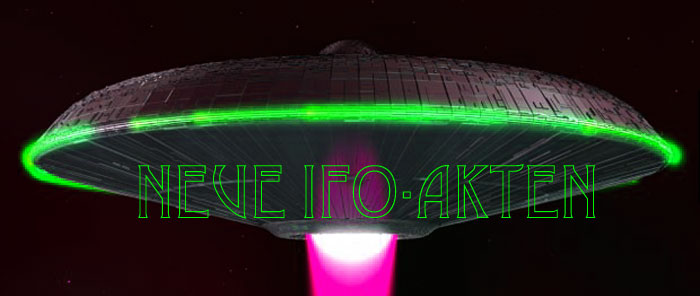
The 701 club - Case 4050: April 4, 1956
Don Berlinner describes this case as follows:
April 4, 1956; McKinney, Texas. 3:15 p.m. Witnesses: Capt. Roy Hall, U.S. Army, ret.; Charles Anderson and others; some observed through a 6” telescope, others through a 55-200x telescope. One fat, oblong object with two lines around its middle, remained stationary for 6 hours.1
The Blue Book file contains a three page letter from witness Roy Hall, which includes a sketch, as seen by the observer, through a six-inch reflecting telescope. Details about the sighting reveal that:2
The object was visible seven degrees north of Venus for the entire 6 hours (3-9PM CST).1.
The object moved slowly westward.2.
The object disappeared after sunset.3.
The object was one minute of arc across. Witness Roy Hall computed that this made the object roughly 200 feet across and 4. about 100,000 feet in altitude.
Witness Roy Hall contacted observers as far west as 100 miles and 50 miles north, who all saw the object. They stated that it 5. appeared overhead to them.
When viewed through the telescope, it appeared to be made of 6. “translucent rubber”.
According to Hall, the upper level winds were moving towards the east.7.
The sketch of the object shows what it appeared like when viewed through the telescope at 200X.8. 3
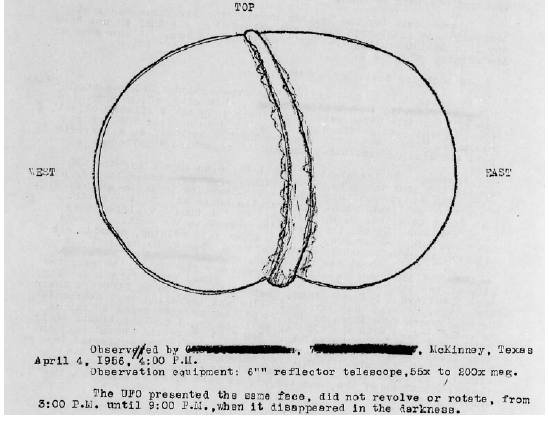
9. “Obj similar to balloon”.4
Blue Book suggested that it was possibly some form of Parahelia due to cirrus clouds in the area at the time but left it as “unidentified”.5 Looking at the sketch and reading the description, it appears that this UFO was a high altitude research balloon. Is it possible that this explanation is adequate?
Additional information
If the object was a balloon of some kind, the first thing one needs to know is what were the upper level winds doing on April 4, 1956. The upper level air soundings for various Texas locations on the fourth of April indicate they were coming from the southwest.
This table shows the rough average wind azimuth/speed (kts) for 30000-50000 feet.6

While these are the winds in the troposphere, the winds in the stratosphere are also important. The general pattern for stratospheric winds to be from the west in the winter and from the east in the summer. The transition months are April/May and September/October.

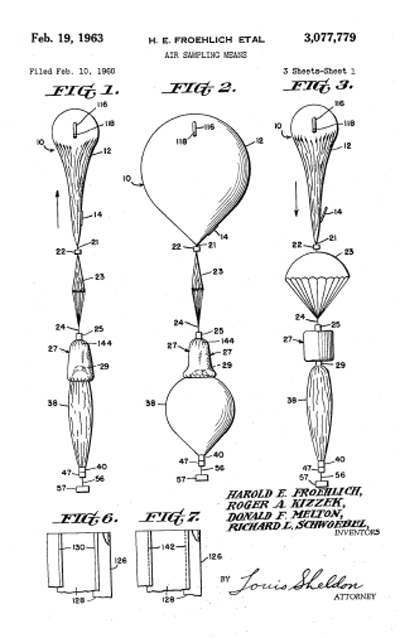
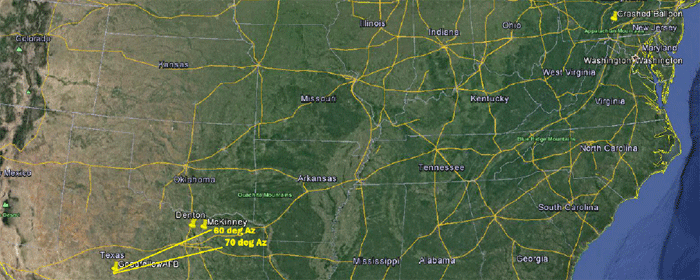
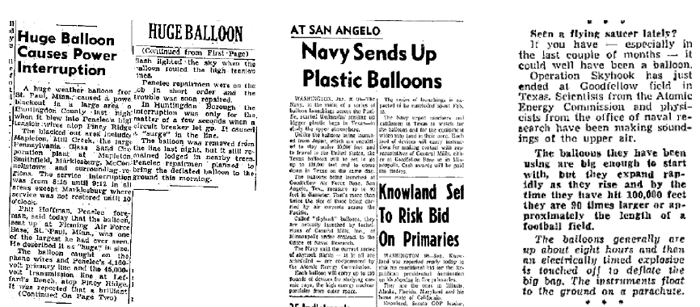

The shift in April and May depends upon the altitude and latitude. The higher the altitude and further south one is, the more likely the stratospheric winds will be coming from the east.7 A balloon at 80,000 feet and at a latitude of 33 degrees north, could have had winds from the east or west on April 4, 1956.

A potential source
The stratocat database lists a balloon launch from Goodfellow AFB on April 4, 1956 as part of project Grab Bag.8 Grab Bag was an effort to gather radioactive isotopes in the stratosphere that were released from Soviet above ground nuclear explosions and nuclear weapons production facilities by using high altitude balloons.
The project Grab Bag balloons were complex systems that used a main balloon to raise the collector into the stratosphere and return it back to earth. The configuration used can be seen in the figure to the right. 9 The system was taken aloft by the lifting balloon
(fig. 1). When in the stratosphere, a collection system would fill up a polyethylene envelope that was suspended underneath the main balloon. When nearly full, the system appeared as two balloons
with one underneath the other (fig. 2). After collection, the system would descend back into the troposphere, where the air in the envelope was transferred to a metallic chamber. When close to the ground, the chamber was dropped via parachute to the ground and the lifting balloon would then vent off and end its flight (fig. 3). Helicopters or chase aircraft would direct/transport recovery crews to the landing site of the chamber for recovery.
Goodfellow AFB was located in San Angelo, Texas at an azimuth of roughly 240 degrees from McKinney and 250 miles away. The upper
level tropospheric winds would have pushed the balloon in a northeast direction towards McKinney. Once the balloon reached the stratosphere, the balloon might have drifted westward with those winds.
A search of the newspaper archive reveals a report in the Denton, Texas newspaper (about 30 miles west of McKinney), which identifies the object as a weather balloon.10 They had called Carswell AFB in Fort Worth and the officer of the day, after checking, stated a C-47 and a fighter jet from Perrin AFB both identified it as such. It seems odd that a C-47 was reported as flying at 45,000 feet while the service ceiling for that plane was below 30,000 feet. This is probably a reference to the altitude of the jet fighter, which also identified the unknown.

The mention of a C-47 seeing the balloon is interesting because, according to an Air Force Times article written
in 1961, the chase plane used in the balloon flights from Goodfellow AFB was a C-47.11 Was the C-47 referenced in the news article, the possible plane used to pursue the balloon launched that day? While the C-47 was still in use in the USAF in 1956, it had been slowly replaced by better aircraft. It may not have been by chance that the C-47 was present. If so, they would have had no problem identifying the object as a balloon.
Examining the stratocat database, we see that there are no records of other balloons being launched from this time period until April 9th, when a balloon had been launched from Minnesota. This brings up another curious situation I found in the newspaper archive.


On April 6, 1956 a large research balloon, which was reported as being launched from St. Paul, Minnesota, caused a power interruption in Pennsylvania roughly halfway between Pittsburgh and Harrisburg.12 The identification of the balloon as being from Minnesota may have had something to do with the reward tags that were probably with the balloon. The General Mills technicians were launching the balloons from Goodfellow and they probably used their own tags, which asked the person discovering the balloon to contact their headquarters in Minnesota. This indicates the balloon could have been the Grab Bag flight launched on the fourth. The straight line azimuth from Goodfellow AFB is about 58 degrees, which is the general direction the balloon would travel if it were below 50,000 feet. Upper level tropospheric winds for the states between Pennsylvania and Texas were from the west and west-southwest during the time period (rough average wind direction for 30,000-50,000 feet).13

257It is also possible that the stratospheric winds could have shifted from east to west as the balloon descended into the lower stratosphere
or moved northwards. Of course, this balloon might have come from elsewhere and was totally unrelated to the events of April 4th. Without more information we can’t be sure if it was the same balloon.
Was it the Grab Bag flight?
Goodfellow had been launching these balloons for some time prior to 1956. On January 17, 1955, the Baytown Sun reported that an Atomic Energy Commission (AEC) balloon launched from Goodfellow AFB had landed on a Dublin, Texas farm.14 In another instance, a July 31, 1955 news clipping from Cedar Rapids mentioned that “Operation Skyhook” balloons were being launched from Goodfellow AFB.15 The mentioning of the AEC indicates they were interested in collecting atomic particles, which is consistent with Grab Bag and Ash Can (a related project) balloon flights..
In late January of 1956, there were several newspapers that carried a story that, once again, balloons were going to be launched from Goodfellow AFB.16 They mention that ten balloons would be launched by General Mills technicians between January and February
and that they were supposed to come down on the same day they were launched. These are what one would expect from Grab Bag missions.
The witness’ sketch indicates that this may have been a Grab Bag balloon. The directions given indicate that the west is towards the left, which is towards the horizon. That means the sketch should be rotated 90 degrees to reflect the proper orientation of the object with respect to the ground. In that arrangement, the drawing begins to resembles a Grab Bag configuration with the lifting balloon on the top and the collection envelope underneath it.
We don’t have a launch time for the April 4th balloon but, based on what is stated about the project, the balloons were launched in the morning and usually took about three hours to reach an altitude of 80,000 feet.17 Assuming this was a standard Grab Bag flight, this implies that it was unlikely that the object seen was the balloon launched from Goodfellow. However, there are issues that might have resulted in the balloon being aloft that evening.

One possibility is that the balloon was not a full Grab Bag flight. According to Curtis Peebles, the initial test phase for the Grab Bag flights started in 1955 and the collection of actual samples did not occur until 1956.18 He adds those early collection flights were only launched from Brazil and the Panama canal zone. His information may not be complete and, based on the news paper accounts, at least some of the flights from Texas appear to have been full Grab Bag configurations. However, the possibility exists that some of them may have been service flights used to test some of the features that would be employed in later configurations. In that case, the standard flight profile may have not been used and the balloon might not have been scheduled to return to earth that day.
It is also possible that the balloon had a malfunction, which resulted in it still being airborne on the evening of the fourth. These systems were complex and there was the potential for a failure that prevented the system from initiating the descent of the balloon. The February 12, 1957 Abilene Reporter-News stated that a balloon released from Goodfellow on February 9th (listed as a Grab Bag flight in the Stratocat database19) had been sighted over Breckenridge and Abilene on the evening of February 11th.20 According to that report, the balloon’s deflation device failed to operate and the balloon stayed aloft for several days.
There also may have been a delay in launching the balloon that morning. The launching of a flight was no easy task and the potential for delays due to equipment malfunction, weather, or air traffic concerns could have resulted in an afternoon launch. Writing about project Grab Bag, Dr. Bernard Gildenberg mentioned
that recovery operations sometimes occurred at night.21 There were also instances where these balloons were seen in the evening. The Brownwood Bulletin reports a high altitude balloon being visible from Brownwood on the 22nd of April (just 18 days later) from 5PM until dark.22 There are no high altitude balloons listed in the Stratocat database (this database is incomplete) but the likely source was probably a balloon from Goodfellow AFB only about 80 miles to the WSW of Brownwood. The only balloons Goodfellow was launching appear to be for project Grab Bag. Like the April 4th balloon over Denton/McKinney, this balloon was airborne in the evening.
While there seems to be several reasons why the balloon could have been airborne that evening, there is another part of the observation that gives one reason to question the balloon explanation. In his letter, Captain Hall, stated that the balloon disappeared around 9PM when it got dark. The sun had set about 6:49PM CST. Nautical twilight ended around 7:44 PM CST and astronomical twilight ended at 8:14 PM CST. This indicates that the sky was essentially dark around 8 PM and the balloon, even though it was in the stratosphere, would have little to no illumination from the sun. It is possible that the witness was a bit off on their time estimate of when the object disappeared. He had written the letter a month after the event, which might have resulted in an inaccurate recall of the exact time they lost track of the balloon. It might have been when twilight was ending and he simply remembered that as being 9PM based on when it got dark when he actually wrote the letter (astronomical twilight ended around 8:44 PM CST on May 14th).
It is also possible that he was able to track the balloon because of the lighting found on the payload. Dr. Bernard Gildenberg states the payload on the Grab Bag flights had lighting23 and Curtis Peebles states that other research balloons usually had anti-collision lighting on their payloads.24 Assuming there was lighting,
it might have allowed the witness to follow the balloon into darkness especially if they were using the six-inch telescope to track the object.

While there are concerns about relating this sighting to the launch of the Grab Bag flight from Goodfellow AFB, they are not strong enough to eliminate this particular balloon as the source for the McKinney sighting. It is important to recognize that pilots of two aircraft identified the UFO as a balloon and the sketch made by the witness through the telescope looks like a balloon of some kind. Without another source, the Grab Bag balloon appears to be the best potential candidate for this UFO report.
Why didn’t Blue Book get this one?
The file consists of a single three-page letter from Captain Hall sent directly to USAF intelligence and nothing else. It does not appear that he ever contacted a local AF base to report the sighting so there was no effort to investigate it. Captain Hall also presented two other sightings of “UFOs” in his letter indicating he might not have been that critical of an observer (despite claiming he did not believe in “flying saucers”).
The big question is why didn’t Carswell report their UFO identification to Blue Book. Apparently, the officer of the day at Carswell, when contacted by the Denton newspaper, made a few inquiries and identified the object they sighted. Because it was identified, I suspect they saw no reason to contact Blue Book or fill out a sighting report. It would not be the first time that a decision of this kind was made by a local commander, who may not want to bother the upper chain of command with, what they felt, useless information.
As a result, the potential key to the puzzle was missed and the object remain “unidentified”.
Is it Solved?
While there are no details (track/launch time/equipment failure report) for the Goodfellow balloon flight of April 4, 1956 that will positively identify this as the source, there is information that suggests it could have been the balloon sighted at McKinney, Texas and elsewhere that evening. Even if the object was not the system launched from Goodfellow, the information from the files indicates it was, very probably, some sort of research balloon. This case should be classified as a probable research balloon.
Quelle: SUNlite 3/2014
4823 Views
